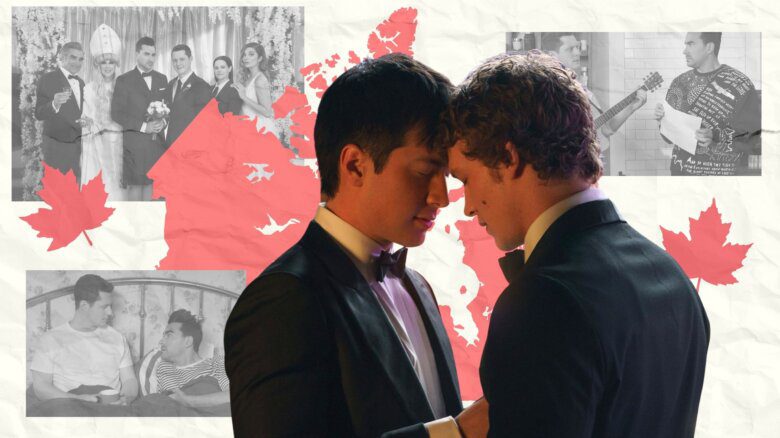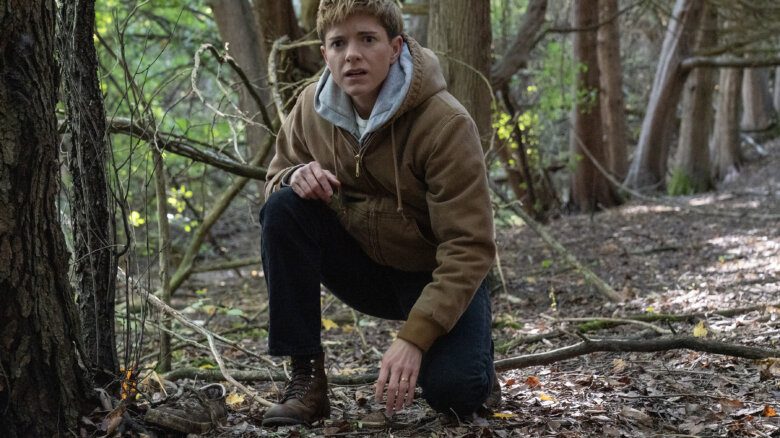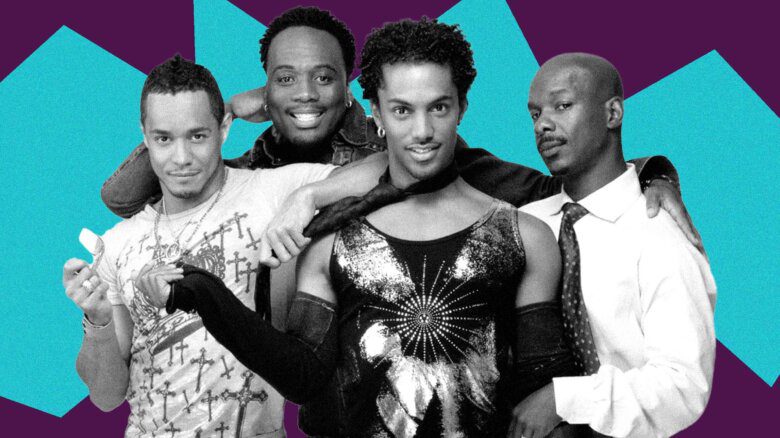My prom was a closeted affair. I went with a sweet young woman named Dolores who shared several classes with me, and we did the whole thing—tuxedo, corsage, pictures, dancing and dinner afterwards at what we thought was a swanky restaurant. There was no thought of going with my best friend, a junior named Robert. Back in 1967, the thought wouldn’t have entered our heads. It wasn’t until 1980 that a gay student, Aaron Fricke, sued his Rhode Island school to bring a boyfriend to his prom. Canada had a similar case in 2002, when Marc Hall sued to take another young man to his prom at a Catholic high school. There were even more headlines in 2010, when parents’ efforts to prevent their children from attending prom in Mississippi with Constance McMillen and her girlfriend led to a celebrity protest and a “second chance” prom that inspired a Broadway musical and its 2020 Netflix film version. So, it’s a special thrill to see young drag queen Jamie New (Max Harwood) win student support in his fight to attend his prom in a dress in the British film musical Everybody’s Talking About Jamie, which premieres on Amazon Prime on Friday, Sept. 17.
The film is the brainchild of book and lyrics writer Tom MacRae, composer Dan Gillespie Sells (of the band The Feeling) and director Jonathan (Jonny) Butterell. MacRae, who grew up in Northamptonshire, England, was primarily a television writer, creator of the series Threesome and author of three well-remembered Doctor Who episodes. Early in their journey of creating something new, MacRae and Sells went to Butterell for advice. He suggested the possibility of a story based on the documentary Jamie: Drag Queen at 16, by Jenny Popplewell, which recounted the true story of Jamie Campbell, a 16-year-old from an ex-mining town in Country Durham, United Kingdom, who wanted to go to his prom in a dress.
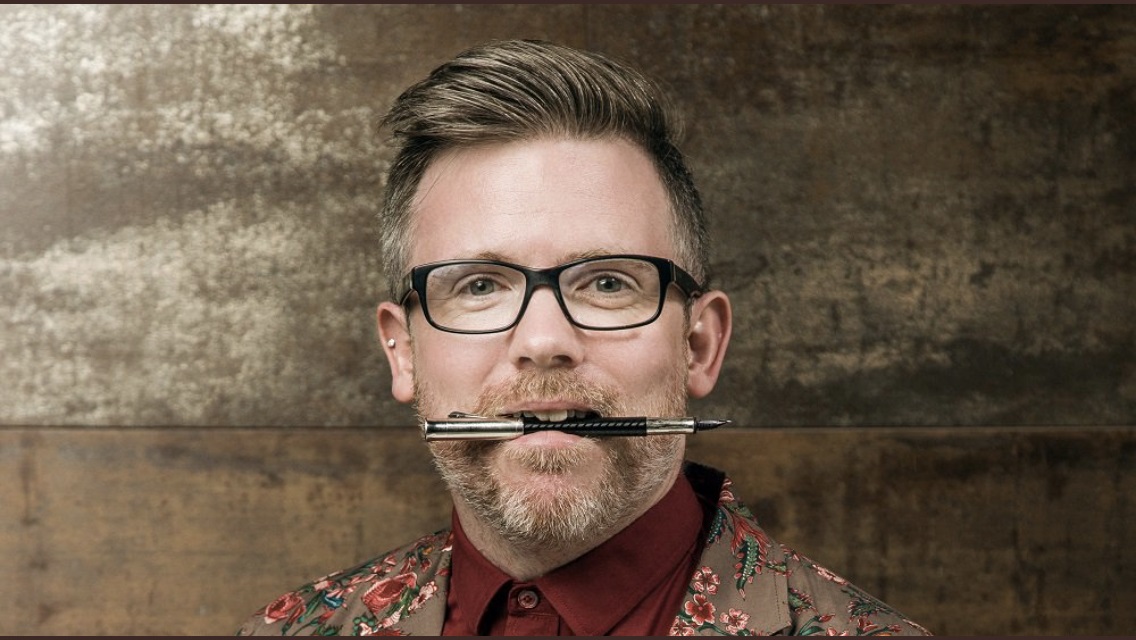
Credit: Nica Burns
“Jonny watched it and thought, ‘This should be a musical,’” says MacRae. They flew with the idea and landed two workshops and a two-week run at Sheffield’s Crucible Theatre.
Although MacRae looked to the documentary for the concept and key plot points, including Jamie’s rejection by his father and the inspirational final scene, the team wanted to create something of their own. They renamed the lead character Jamie New and moved the action from Campbell’s native Newcastle to Sheffield, where Butterell had grown up. They also held off meeting Campbell and his mother until after the show had been completed. MacRae only watched the documentary once.
“I didn’t want to have two Jamies in my head when we were trying to figure out what our Jamie was,” he says. Surprisingly, when MacRae and his collaborators met the Campbells, the real characters spoke almost exactly like their stage counterparts. Jamie Campbell’s father had declined to participate in the documentary—so there was little foundation to build on for that character— but on seeing the staged confrontation between Jamie New’s parents, real-life mother Margaret told MacRae that that was exactly what she had said to her ex-husband.
After Sheffield and a successful run in London’s West End, the film adaptation was green-lit. Disney acquired the distribution rights in 2019—Jamie should have become a Disney princess. But with COVID-19 leading to delays in distribution, Disney sold the film to Amazon’s streaming service. “It’s lucky,” MacRae says, “and it all fell in our laps in the right way.”
“I didn’t realize how many teenage girls would come and fall in love with Jamie because he could be their best friend.”
In its Sheffield and London productions, MacRae was surprised to discover the musical had a wider appeal than he’d anticipated. “I knew the kind of queer kids and the club kids and the drag kids who would want to see a show that celebrates a hero who reflects them. I didn’t realize how many teenage girls would come and fall in love with Jamie, not because they could have him romantically, but for the idea that he could be their best friend.” Beyond that, the show also developed a cross-generational appeal, with grandparents bringing their grandchildren, and gay and straight couples coming on dates.
“I was really surprised by just how wide a demographic really related to the story and the different reasons why people who aren’t drag queens or kids find something in that to see their own life in,” MacRae says.
One reason for this cross-generational appeal may be that the show’s creators share a common working-class background. Jamie Campbell didn’t attend a private school, nor does Jamie New in the musical. To get the money to buy his first drag gown, the fictional Jamie has to deliver newspapers, stack shelves in a market and make sandwiches for a caterer. As MacRae puts it, the shared background means that he, the composer, the director and even the film’s star, get to “tell a working-class story with the sort of authenticity of our own experience. I think it gives it something very special.”
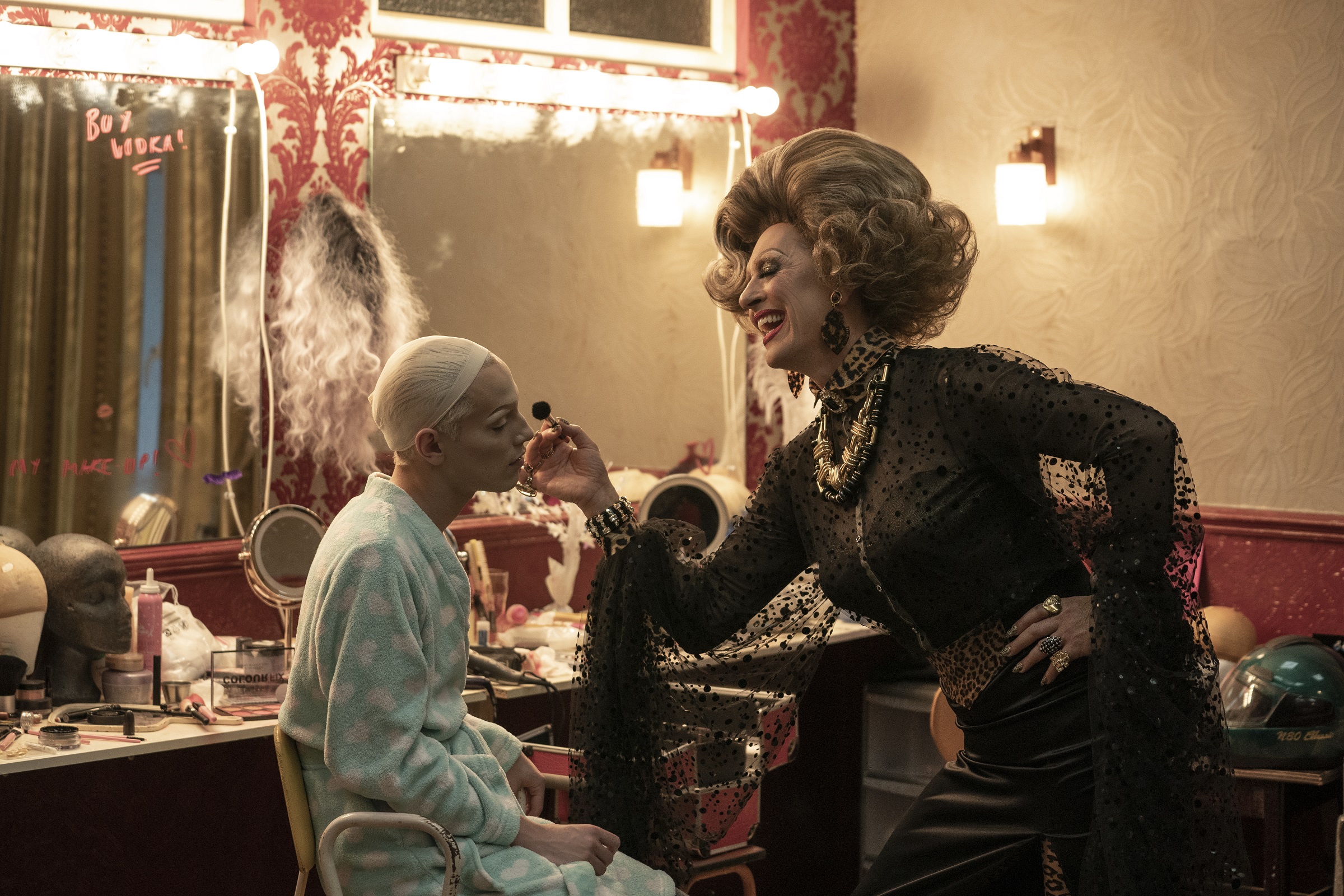
Credit: Courtesy of Amazon Prime
And the film, indeed, is something special. Everybody’s Talking About Jamie is very much a part of its working-class milieu. Jamie and his mother (Sarah Lancashire) live in a tract house in industrial Sheffield. They travel mostly by bus and bicycle, and the mother holds down a job in a shop, taking extra shifts to make up for an absent husband who deserted them because he couldn’t deal with having a gay son. Jamie goes to a racially diverse public school where he’s bullied for his effeminacy, and the teachers seem devoted to dashing their student’s dreams. The main teacher, Miss Hedge (Sharon Horgan), wears fashion knock-offs and advises most of her students to prepare themselves for careers processing meat or working in warehouses.
Jamie’s dreams transform the place. When he lapses into a fantasy during class to launch his first musical number, “You Don’t Even Know It,” the desks in the classroom light up with neon colours, and the room turns into a chic club. Later, his best friend, Pritti (Lauren Patel), advises him to follow his dreams as she breaks into the song “Spotlight.” They’re sitting in an empty cafeteria that suddenly shimmers under spotlights. The cleaning women turn into her back-up singers with sequined gowns and bedazzled mops.
As Jamie discovers himself through drag, he’s also transformed as a person. At the urging of Hugo (Richard E. Grant), a drag queen running a nearby second-hand clothing shop, he signs on to perform at a local club. With Hugo’s help, he becomes a stunning blonde in a slinky red dress, lip-syncing to a vocal by British pop star Beverley Knight. It’s a terrific number, and Harwood is simply electric. It’s also an addition to the stage score. Because Jamie is almost always on stage in the theatrical version, there was no time to put him into full drag; his number at the club is only described by his fellow students.
“They recruited RuPaul’s Drag Race alum Bianca Del Rio to provide what MacRae calls ‘moment of magic.’”
Some of the other changes from the stage version are obvious. The action moves into more locations, and the chorus of 12 that represents other students and townspeople is expanded, so the entire school is teeming with life. The film’s creators also provide a cameo for drag icon Bianca Del Rio, who had become friends with MacRae, Sells and Buttterell during her tours in England. They recruited the RuPaul’s Drag Race alum to provide what MacRae calls “a moment of magic” for Jamie when he’s trying to get up the courage to do the drag show.
An inevitable change from the stage show is the breaking up of the musical numbers into shorter cuts. One of my main issues with contemporary film musicals is that the directors keep turning them into music videos; instead of the joy of seeing a performer build a number and help develop the dramatic action through song and dance, as happens on stage, the builds and excitement come mostly from editing. In Ryan Murphy’s 2020 adaptation of The Prom, Nicole Kidman’s big dance number is so fragmented you might wonder if they used a dance double. Butterell still cuts frequently during the numbers but, thankfully, also includes some longer takes. You get to appreciate the performances in pieces like “You Don’t Even Know It” and “Everybody’s Talking About Jamie.” And Harwood gets to shine in some longer takes during his drag number.
Lancashire is equally well showcased in her big musical moment, “He’s My Boy,” a number motivated by an argument with Jamie in which he’s clearly in the wrong. One of the problems with the recent rise in films about LGBTQ2S+ life is the tendency to turn queer characters into the equivalent of what Black critics and scholars have come to label “The Magical Negro,” the minority character so saintly that they’re more of a device than a human being. The 2018 rom com Love, Simon is a case in point: the title character states in voiceover, “I’m just like you,” then the film spends the next 110 minutes showing us how privileged his life is. By contrast, Jamie is effeminate, working-class, rejected by his father and the subject of some serious bullying by classmates and his teacher. MacRae was excited to put a character like that in the foreground. Jamie is the type, he says, “who would usually be the comic relief best friend or would die in Act Three.”
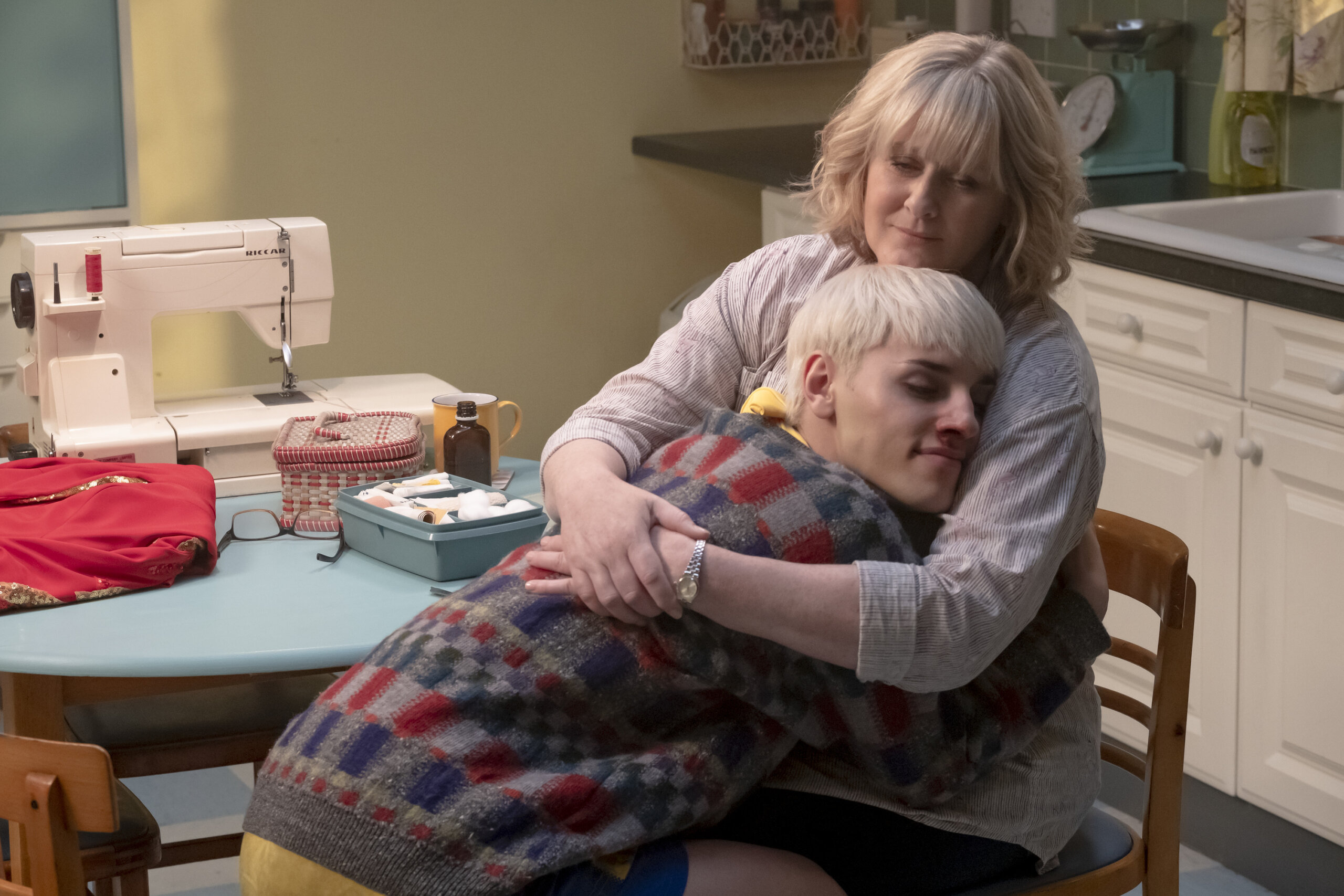
Credit: Courtesy of Amazon Prime
Jamie also makes mistakes. Flush with the excitement of his debut at the drag club, he shows up at school the next day in full makeup, a move even his best friend considers more a show of ego than an expression of self. There’s also a scene in which he explodes at his mother for no good reason. For MacRae, that kind of acting out is a normal part of growing up.
“He’s a teenager,” he says, “and teenagers are awful. [They have] that current of complete, myopic self-centredness whilst at the same time being cripplingly insecure, which every teenager has, particularly gay teenagers. So, it has to be that complex because that’s the truth of the story.”
Though a lot of the film’s truth and authenticity comes from its creators, the cast also deserves a great deal of credit. Bowman and Grant manage to camp it up while giving a clear sense of what it is that motivates their characters’ going over the top. But they can also turn on a dime to create fiercely sympathetic moments. Lancashire, who’s probably best known here for the crime series Happy Valley, makes Margaret, the mother, another powerfully human character. The strength of the work goes down to even the smaller roles: as Dean, the main bully, Samuel Bottomley captures the sense of a kid revelling in power while fully aware that it’s only temporary; when he graduates he’ll go from ruling the high school to serving time in some menial, soul-crushing job.
The humanity of all its characters is one of Everybody’s Talking About Jamie’s greatest selling points. It’s another reason the play has attracted a loyal fan base cutting across boundaries of age and gender. For MacRae, the movie “lives alongside the stage show, which isn’t going anywhere.” With the reopening of theatres around the world, the play is back in the West End and on tour in the U.K. A company recently opened in Japan, and there are plans to bring a production to Italy. Asked if the play could head to Broadway, MacRae can only say: “I hope so. If Jamie’s taught me anything, it’s that dreams can come true.”
Everybody’s Talking About Jamie streams on Amazon Prime starting Friday, Sept. 17.
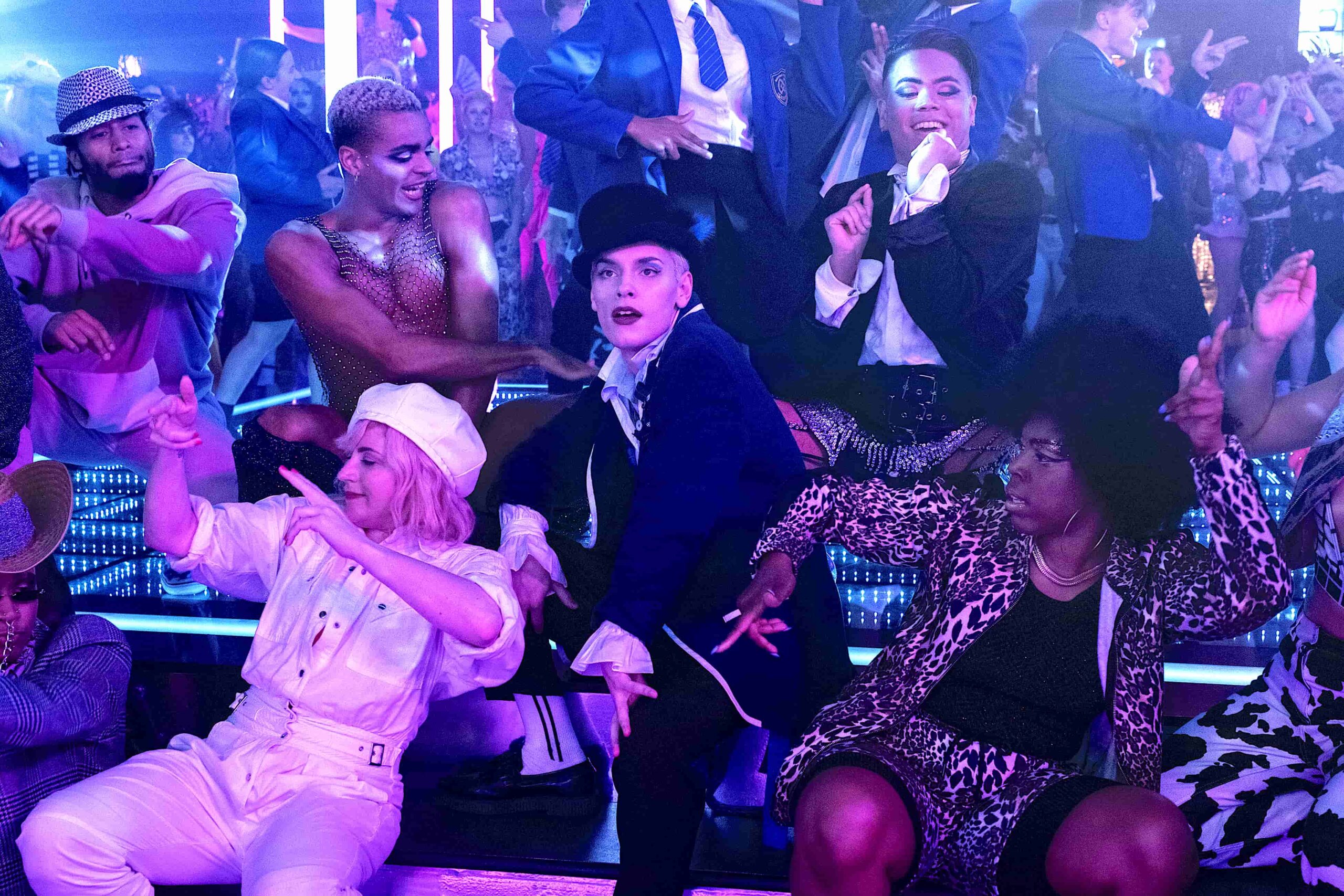

 Why you can trust Xtra
Why you can trust Xtra